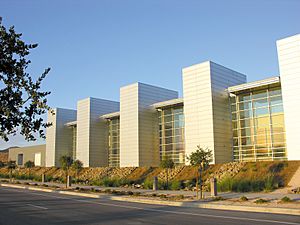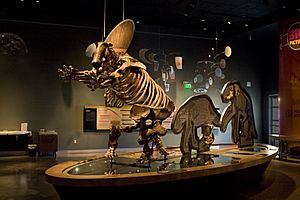Western Science Center facts for kids

The Western Science Center campus.
|
|
| Former name | Western Center for Archaeology & Paleontology |
|---|---|
| Established | 2006 |
| Location | 2345 Searl Parkway Hemet, CA 92543 |
| Opening hours | Tuesday - Sunday, 10am – 5pm |
The Western Science Center (WSC) is a museum in Hemet, California, located near Diamond Valley Lake. It is home to a huge collection of Ice Age fossils and Native American artifacts. These treasures were discovered when the lake was being built.
The museum's most famous residents are "Max," the largest mastodon ever found in the western United States, and "Xena," a giant Columbian mammoth. The WSC also has dinosaur fossils that were brought from New Mexico.
Opened in 2006, the museum was built to be a top-notch place for scientists to study, protect, and display the nearly one million items found in the area.
Contents
A Museum for the Planet
The Western Science Center is one of the most environmentally friendly museums in the country. The building was designed to be "green" and save energy.
It has solar panels on the roof to create its own electricity. To help with air conditioning, cold water runs through pipes under the floor. The gardens outside use native plants that don't need much water. The museum also recycles and reclaims as much water as possible.
Because of these features, the museum earned a LEED Platinum award in 2008. This is the highest honor given by the US Green Building Council for green buildings. The WSC was the first museum in the United States to get this award.
Journey Through Time Exhibits

When you visit the museum, your journey starts before you even go inside. A 156 feet (48 m) long walkway shows a timeline of life on Earth. Inside the lobby, giant 24 feet (7.3 m) high walls look like layers of rock, with replica fossils sticking out.
Local History
The first exhibits teach you about the natural history of the area. You can see artifacts from the Domenigoni family, who first settled in the valley. You can also learn about the Soboba band of Luiseño Indians, who lived there long before.
Ice Age Giants
In a special 270-degree theater, you can watch movies about the building of Diamond Valley Lake and the animals of the Pleistocene era, also known as the Ice Age. The theater even shakes to make you feel like you're part of the action!
After the movie, you enter the paleontology gallery. This room is filled with amazing fossils found in the valley. The main attractions are the huge skeletons of "Max" the mastodon and "Xena" the Columbian mammoth.
You can also see "Li'l Stevie," another mastodon. This fossil is special because it's displayed just as it was found, still partly buried in the dirt. The gallery also has the skeleton of a Harlan's ground sloth and fun, interactive displays about archaeology and paleontology.
Prehistoric Pathways
In 2021, the museum opened a new gallery called Prehistory Pathways. This section focuses on dinosaur fossils found in New Mexico's Menefee Formation. It features the hadrosaur Ornatops, a type of duck-billed dinosaur. The main fossil used to identify this new species is at the museum. The gallery also includes cool artwork and models of what these dinosaurs looked like.
Become a Scientist
The museum has a large, pretend dig site where you can see how archaeologists and paleontologists work. Local students use this site to learn the right way to dig for fossils and artifacts. Visitors can watch a real dig in progress and see what it's like to uncover history.
Smithsonian Partnership
In 2008, the Western Science Center became an official partner of the Smithsonian Institution. This means it is part of a special group of museums that work with the famous Smithsonian in Washington, D.C.

